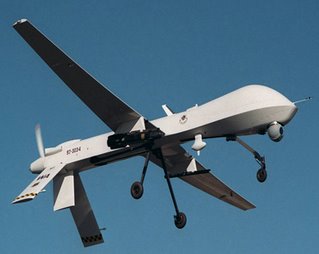


|

|
|
|
Home |
The Mil & Aero Blog
 Posted by John Keller I think we're seeing the future of network-centric surveillance in a U.S. Air Force project called Wide-Area Surveillance that seeks to blend information from many different imaging sensors into 3-D views of areas of interest. This vision appears in a story in the Aviation Week and Space Technology blog entitled U.S. Air Force Eyes New Surveillance System that talks about Pentagon planning to develop an electro-optical intelligence system beginning sometime next year. Writes Av Week: Dubbed "wide area surveillance," the project stems from a prototype now operating in Iraq. The prototype system, built by the Air Force Research Laboratory and called Angel Fire, comprises multiple commercial cameras capable of collecting 1-2 frames per second. They are perched on a twin-engine, manned aircraft, which is being operated by contract personnel, the sources say. Images collected from the cameras can be "stitched" together using computers to present a near-360-degree vantage of a wide area. They may also be displayed in rapid succession to form a product similar to video. It is this stitching together of images from different sensors that is so intriguing. They re talking about several sensors on one aircraft, but what is to prevent smart systems designers from blending images from many sensors on different platforms -- manned and unmanned aircraft, orbiting satellites, surveillance balloons, combat vehicles, and even from gun sights on individual soldiers' weapons. What might this kind of system yield? I can imagine the ability to mouse through a computer image and travel above, around, below, and inside areas of interest. This kind of imagery potentially could even add the dimension of time. Users could look around and inside areas of interest in real time, and then compare those images to the same images one hour, one day, or one week in the past. Computer signal processing can do amazing things these days. The television weather man can give me his "futurecast" of storms many hours in the future. What if computers could extrapolate future events based on what has happened in the past? Might a multisensor system be able to shift us between the past, present, and future of surveillance areas of interest? I know what you're probably thinking, because I saw that movie, too. Remember Deja Vu with Denzel Washington, which came out in 2006? It's a movie with the same kind of speculation, and you ought to take a look at it if you can suspend disbelief and can get through the car chases. Still, this would be groundbreaking capability -- view from any angle from any time. This would be of immeasurable benefit, but only if we remember to trust what we can see with the naked eye. 0 Comments:
<< Home |
Welcome to the lighter side of Military & Aerospace Electronics. This is where our staff recount tales of the strange, the weird, and the otherwise offbeat. We could put news here, but we have the rest of our Website for that. Enjoy our scribblings, and feel free to add your own opinions. You might also get to know us in the process. Proceed at your own risk. 
John Keller is editor-in-chief of Military & Aerospace Electronics magazine, which provides extensive coverage and analysis of enabling electronic and optoelectronic technologies in military, space, and commercial aviation applications. A member of the Military & Aerospace Electronics staff since the magazine's founding in 1989, Mr. Keller took over as chief editor in 1995.  Courtney E. Howard is senior editor of Military & Aerospace Electronics magazine. She is responsible for writing news stories and feature articles for the print publication, as well as composing daily news for the magazine's Website and assembling the weekly electronic newsletter. Her features have appeared in such high-tech trade publications as Military & Aerospace Electronics, Computer Graphics World, Electronic Publishing, Small Times, and The Audio Amateur.
Courtney E. Howard is senior editor of Military & Aerospace Electronics magazine. She is responsible for writing news stories and feature articles for the print publication, as well as composing daily news for the magazine's Website and assembling the weekly electronic newsletter. Her features have appeared in such high-tech trade publications as Military & Aerospace Electronics, Computer Graphics World, Electronic Publishing, Small Times, and The Audio Amateur.
 John McHale is executive editor of Military & Aerospace Electronics magazine, where he has been covering the defense Industry for more than dozen years. During that time he also led PennWell's launches of magazines and shows on homeland security and a defense publication and website in Europe. Mr. McHale has served as chairman of the Military & Aerospace Electronics Forum and its Advisory Council since 2004. He lives in Boston with his golf clubs.
John McHale is executive editor of Military & Aerospace Electronics magazine, where he has been covering the defense Industry for more than dozen years. During that time he also led PennWell's launches of magazines and shows on homeland security and a defense publication and website in Europe. Mr. McHale has served as chairman of the Military & Aerospace Electronics Forum and its Advisory Council since 2004. He lives in Boston with his golf clubs.
Previous Posts
Archives
|
|||||
|
THE MAE WEBSITE AUTHORS ARE SOLELY RESPONSIBLE FOR THE CONTENT AND ACCURACY OF THEIR BLOGS, INCLUDING ANY OPINIONS THEY EXPRESS, AND PENNWELL IS NOT RESPONSIBLE FOR AND HEREBY DISCLAIMS ANY AND ALL LIABILITY FOR THE CONTENT, ITS ACCURACY, AND OPINIONS THAT MAY BE CONTAINED HEREIN. THE CONTENT ON THE MAE WEBSITE MAY BE DATED AND PENNWELL IS UNDER NO OBLIGATION TO PROVIDE UPDATES TO THE INFORMATION INCLUDED HEREIN.
|
||||||
|
|
Home | About Us | Contact Us | Corporate Website | Privacy Policy | Courage and Valor Foundation | Site Map
Also Visit: Laser Focus World | Vision Systems Design | Industrial Laser Solutions Copyright © 2007: PennWell Corporation, Tulsa, OK; All Rights Reserved. | Terms & Conditions | Webmaster |